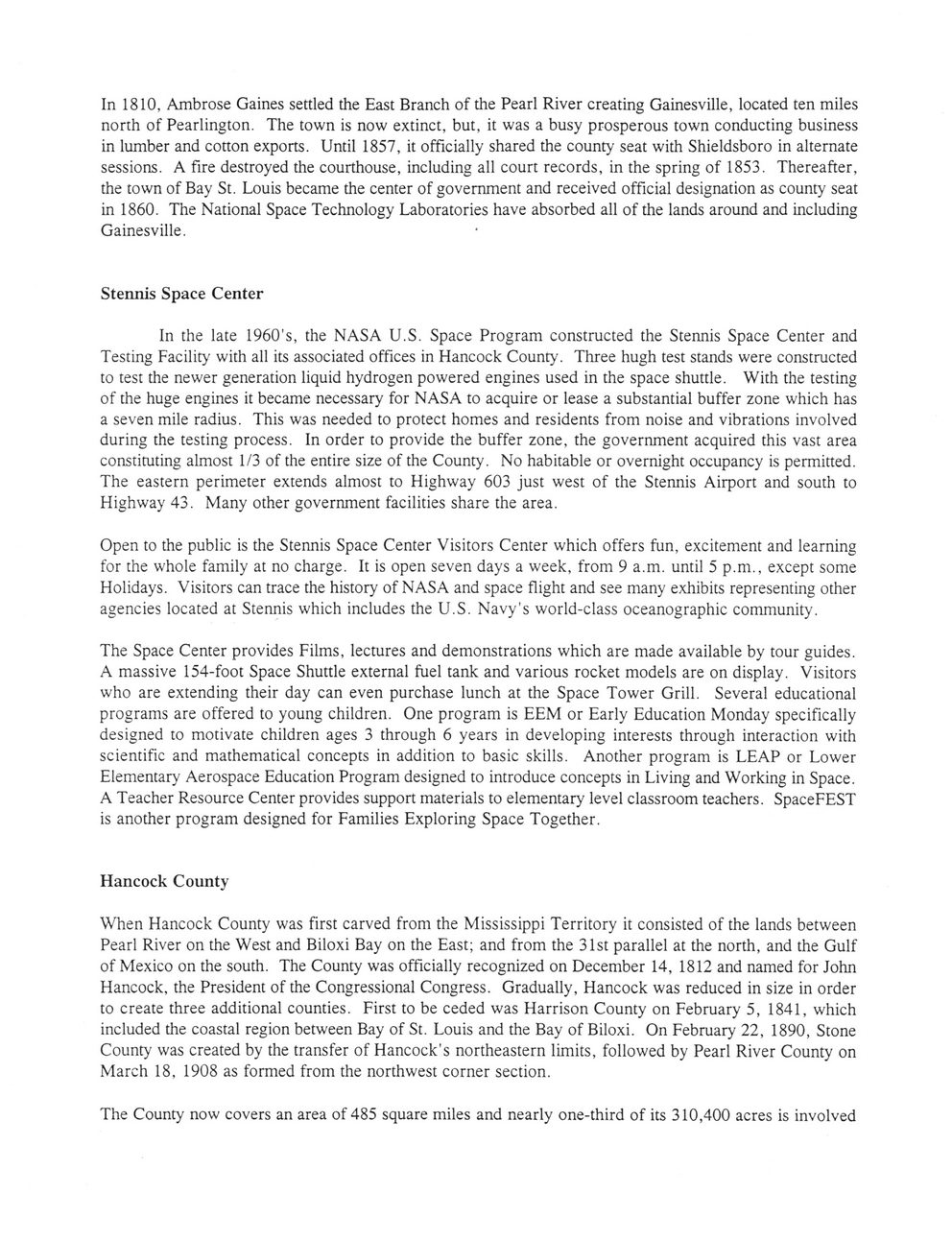This text was obtained via automated optical character recognition.
It has not been edited and may therefore contain several errors.
In 1810, Ambrose Gaines settled the East Branch of the Pearl River creating Gainesville, located ten miles north of Pearlington. The town is now extinct, but, it was a busy prosperous town conducting business in lumber and cotton exports. Until 1857, it officially shared the county seat with Shieldsboro in alternate sessions. A fire destroyed the courthouse, including all court records, in the spring of 1853. Thereafter, the town of Bay St. Louis became the center of government and received official designation as county seat in 1860. The National Space Technology Laboratories have absorbed all of the lands around and including Gainesville. Stennis Space Center In the late 1960's, the NASA U.S. Space Program constructed the Stennis Space Center and Testing Facility with all its associated offices in Hancock County. Three hugh test stands were constructed to test the newer generation liquid hydrogen powered engines used in the space shuttle. With the testing of the huge engines it became necessary for NASA to acquire or lease a substantial buffer zone which has a seven mile radius. This was needed to protect homes and residents from noise and vibrations involved during the testing process. In order to provide the buffer zone, the government acquired this vast area constituting almost 1/3 of the entire size of the County. No habitable or overnight occupancy is permitted. The eastern perimeter extends almost to Highway 603 just west of the Stennis Airport and south to Highway 43. Many other government facilities share the area. Open to the public is the Stennis Space Center Visitors Center which offers fun, excitement and learning for the whole family at no charge. It is open seven days a week, from 9 a.m. until 5 p.m., except some Holidays. Visitors can trace the history of NASA and space flight and see many exhibits representing other agencies located at Stennis which includes the U.S. Navy's world-class oceanographic community. The Space Center provides Films, lectures and demonstrations which are made available by tour guides. A massive 154-foot Space Shuttle external fuel tank and various rocket models are on display. Visitors who are extending their day can even purchase lunch at the Space Tower Grill. Several educational programs are offered to young children. One program is EEM or Early Education Monday specifically designed to motivate children ages 3 through 6 years in developing interests through interaction with scientific and mathematical concepts in addition to basic skills. Another program is LEAP or Lower Elementary Aerospace Education Program designed to introduce concepts in Living and Working in Space. A Teacher Resource Center provides support materials to elementary level classroom teachers. SpaceFEST is another program designed for Families Exploring Space Together. Hancock County When Hancock County was first carved from the Mississippi Territory it consisted of the lands between Pearl River on the West and Biloxi Bay on the East; and from the 31st parallel at the north, and the Gulf of Mexico on the south. The County was officially recognized on December 14, 1812 and named for John Hancock, the President of the Congressional Congress. Gradually, Hancock was reduced in size in order to create three additional counties. First to be ceded was Harrison County on February 5, 1841, which included the coastal region between Bay of St. Louis and the Bay of Biloxi. On February 22, 1890, Stone County was created by the transfer of Hancock's northeastern limits, followed by Pearl River County on March 18, 1908 as formed from the northwest corner section. The County now covers an area of 485 square miles and nearly one-third of its 310,400 acres is involved

Ellis, Dan 009